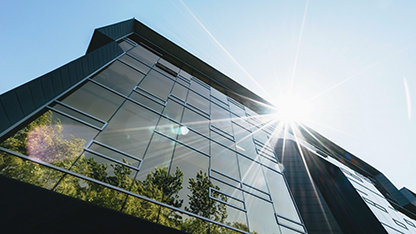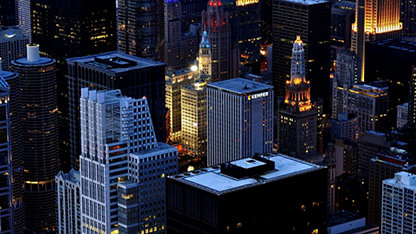The built environment is slow to adapt to new concepts and drivers for change for a variety of reasons, but the necessity for immediate action and paradigm shift created by COVID-19 can be both a catalyst and accelerator to the pace of change for the industry.
It is unclear what the impact of the pandemic will be on the overall economy and industry, but perhaps in some regards the ‘new normal’ for the built environment will be years ahead of where it would have been without COVID-19.
Surveying during lockdown
There has been a significant slowing to the real estate market – for example Savills research shows that at the end of April investment volume in central London offices was 39 per cent down on the same point last year.
Many of us have needed to adapt our working practices and the services we provide – it’s unprecedented for built environment professionals to spend 100% of their time at their desks. I suspect that a good few historic dilapidations negotiations have been dusted off and perhaps even settled over recent weeks. At Savills we have looked to progress desktop instructions where possible to ensure we and our clients have our ‘ducks in a row’ in preparation for the return of increased market activity.
While transactional activity and associated work may have been quieter than normal over recent months, the management and monitoring of construction projects has been more demanding than ever. Furloughing, travel restrictions, social distancing and availability of materials have all been significant challenges; ‘there’s no plasterboard in London’ has been mentioned in quite a few meetings.
These challenges and government guidance has needed to be assessed site-by-site. For a regional logistics/warehouse development, people can generally drive to work and social distancing restrictions can be managed more easily. In contrast, high rise developments in city centres have significant challenges around public transport use and vertical access between floors due to the reduced lift capacities required to comply with social distancing measures. It has been a busy time advising clients through the impact and potential recovery scenarios associated with COVID-19 for the construction industry.
Video calls, drone inspections, 3D scanning, building modelling and 360 imagery –these tools were already creeping into the built environment, but the necessity of remote working has required us to use them. Personally, my view is that there will never be a substitute for an inspection, or the individual undertaking the inspection, but being forced to use the technology has certainly progressed our use and adjusted our perception of it.
Accelerating change
We are now assessing the industry from our mid-pandemic perspective, which is bringing a sharper focus and increased desire to drive forward change. Movements which were already gathering momentum can now be fundamental to the speed and success of our recovery:
Science is telling us that an accelerating rate of global warming is the world’s next crisis and COVID-19 has enabled us to glimpse what the world might be like if buildings, transport and industry had less impact upon it. In 2019 the government passed legislation requiring the UK to reduce carbon missions to net zero by 2050. Today the built environment contributes towards 40% of the UK’s carbon emissions and 80% of the existing building stock will still be standing in 2050, according the UK Green Building Council.
Clearly, there is a huge requirement to upgrade existing buildings in order to come close to the 2050 target, an area we as industry professionals can all significantly contribute towards. Over recent months we have clearly seen what the world can be like if we reduce emissions – reduced air pollution, carbon emissions, cleaner waters and reduced long-term climate change risk. Environmental legislation and taxation is likely to be a theme over the coming years. Combined with the COVID-19 impact, these influences will hopefully accelerate our progression towards a cleaner, more efficient, healthier and environmentally-conscious built environment.
The design of our buildings was already responding more intuitively to human behaviours and comfort requirements. COVID-19 has however effectively turbo-charged this movement due to the immediate social distancing requirements and potential long-term nervousness. Our perception of more fundamental requirements has also changed – we now understand with more clarity that we need natural daylight, fresh air/natural ventilation, outside space, biodiversity and cycling facilities in and out of the workplace. We will need to quickly assess and adapt to these heightened demands.
“We now understand with more clarity that we need natural daylight, fresh air/natural ventilation, outside space, biodiversity and cycling facilities in and out of the workplace ”
Proptech has been a ‘hot topic’ for many years, but we now have a very physical desire for it – to touch things and each other less. Facial recognition systems and sensor-driven toilet facilities, security access control, door openings, kitchens, printers, and passenger lift controls are all likely to become commonplace. Our requirement for data will also increase due to the pandemic; we will want to track occupant behaviours and movement, air quality, humidity, energy use and waste from buildings. Improved monitoring, using more sophisticated metering and building management systems will deliver improved visibility and control of the performance of buildings. As a result, a positive impact of COVID-19 will be an improvement in our ability to interpret actual building performance, helping to improve building design and to reduce the current gap between design and actual performance.
Finally, who picks up the cost to the construction industry for COVID-19 delays and overspends is yet to be seen. Can the industry negotiate amicable outcomes for developers and contractors alike, or will the wording of contracts and legal amendments be followed to the letter? Perhaps taking on a degree of the pain from COVID-19 is the opportunity to create increased risk sharing on projects moving forward.
Some movement away from the favoured design and build procurement was however already happening pre-pandemic; off-site construction, new materials and technologies are changing supply chains and early contactor collaboration is being used to maximise procurement efficiencies. Offsite manufacturing and more standardisation must be the way forward to reduce well known industry issues with workmanship, health and safety, weather delays, wastage and even social distancing compliance – all can be managed much more effectively in a controlled offsite environment. COVID-19 only seems to support the drive towards collaboration and modernisation of our construction processes.
While it is unclear what impact the pandemic will have on the overall economy and the built environment, I believe that we should be excited about the role we can play in the period of accelerated change that will follow.
- Chris Skinner is an associate director, building and project consultancy at Savills and a member of RICS Built Environment Journal’s building surveying editorial advisory group: cskinner@savills.com














